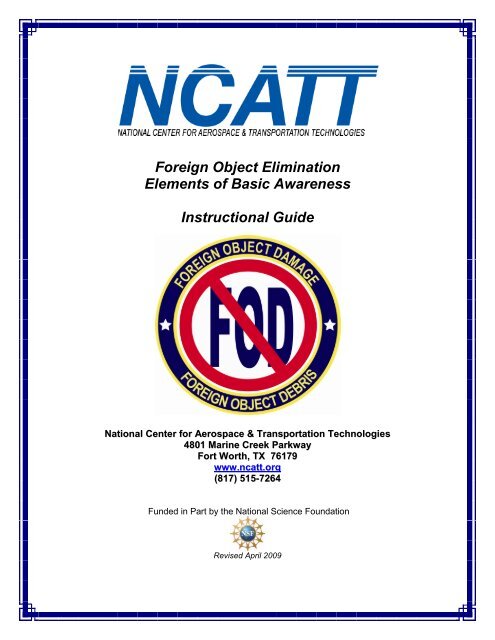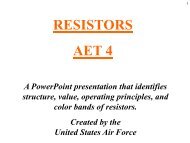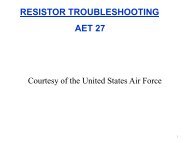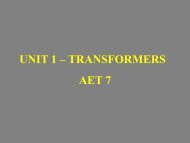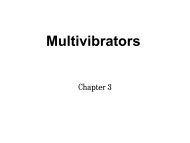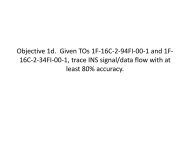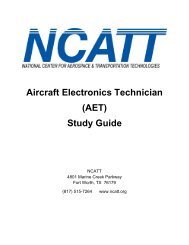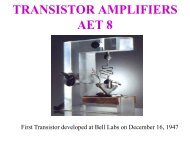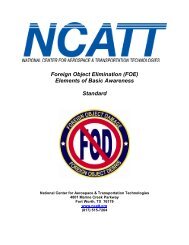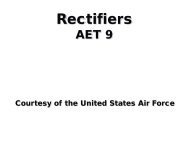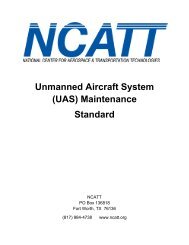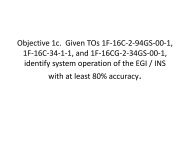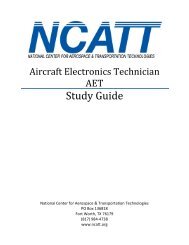Foreign Object Elimination Elements of Basic Awareness ... - NCATT
Foreign Object Elimination Elements of Basic Awareness ... - NCATT
Foreign Object Elimination Elements of Basic Awareness ... - NCATT
Create successful ePaper yourself
Turn your PDF publications into a flip-book with our unique Google optimized e-Paper software.
<strong>Foreign</strong> <strong>Object</strong> <strong>Elimination</strong><br />
<strong>Elements</strong> <strong>of</strong> <strong>Basic</strong> <strong>Awareness</strong><br />
Instructional Guide<br />
National Center for Aerospace & Transportation Technologies<br />
4801 Marine Creek Parkway<br />
Fort Worth, TX 76179<br />
www.ncatt.org<br />
(817) 515-7264<br />
Funded in Part by the National Science Foundation<br />
Revised April 2009
Page 1 <strong>of</strong> 16<br />
National Center for Aerospace & Transportation Technologies (<strong>NCATT</strong>)<br />
<strong>Foreign</strong> <strong>Object</strong> <strong>Elimination</strong> – <strong>Elements</strong> <strong>of</strong> <strong>Basic</strong> <strong>Awareness</strong><br />
Instructional Guide<br />
DESCRIPTION<br />
The for <strong>Foreign</strong> <strong>Object</strong> <strong>Elimination</strong> - <strong>Elements</strong> <strong>of</strong> <strong>Basic</strong> <strong>Awareness</strong> addresses twelve industry identified basic<br />
knowledge areas, activities and functions designed to prevent foreign objects from entering aerospace products.<br />
The standards are derived from NAS 412 – <strong>Foreign</strong> <strong>Object</strong> Damage / <strong>Foreign</strong> <strong>Object</strong> Debris (FOD) Prevention.<br />
The standards for FOE – <strong>Elements</strong> <strong>of</strong> <strong>Basic</strong> <strong>Awareness</strong> – Instructional Guide can be used by industry and FAA<br />
Part 147 schools to develop lesson plans as part <strong>of</strong> a complete entry-level or specialized FOE / FOD education<br />
and training program.<br />
Education and training programs that utilize all <strong>of</strong> the material covered in this <strong>NCATT</strong> FOE - <strong>Elements</strong> <strong>of</strong> <strong>Basic</strong><br />
<strong>Awareness</strong> Instructional Guide will prepare motivated, pro-active FOE / FOD students and technicians for the<br />
aerospace industry. Education and training programs that utilize this document will successfully prepare students<br />
and technicians for the <strong>NCATT</strong> FOE – <strong>Elements</strong> <strong>of</strong> <strong>Basic</strong> <strong>Awareness</strong> Certification exam.<br />
REFERENCES<br />
• National Center for Aircraft Technician Training (www.ncatt.org) PowerPoint FOE <strong>Basic</strong>s and other<br />
reference materials on the website<br />
• FAA Advisory Circulars 150/5370-2E &150/5380-5B (www.faa.gov)<br />
• Guidelines for The Prevention and <strong>Elimination</strong> <strong>of</strong> <strong>Foreign</strong> <strong>Object</strong> Damage/Debris (FOD) in the Aviation<br />
Maintenance Environment Through Improved Human Performance, by David C. Kraus, Galaxy Scientific<br />
Corporation and Jean Watson, FAA Flight Standards Service, Aircraft Maintenance Division<br />
(www.hf.faa.gov)<br />
• NAS 412 – <strong>Foreign</strong> <strong>Object</strong> Damage / <strong>Foreign</strong> <strong>Object</strong> Debris (FOD) Prevention Aerospace Industries<br />
Association (www.aia-aerospace.org)<br />
• National Aerospace FOD Prevention Inc. Guidelines (www.nafpi.com)<br />
• The FOD Control Cooperation (www.fodcontrol.com), (www.fodnews.com), (www.makeitfodfree.com)<br />
• Wildlife and Bird Strike Organization (www.birdstrike.org)<br />
GENERAL COURSE INSTRUCTIONAL GOALS<br />
The following list <strong>of</strong> general course instructional goals will be addressed. These goals are directly related to the<br />
standards for FOE – <strong>Elements</strong> <strong>of</strong> <strong>Basic</strong> <strong>Awareness</strong>. During the course <strong>of</strong> instruction the instructor will:<br />
I. Describe and explain the standards for FOE – <strong>Elements</strong> <strong>of</strong> <strong>Basic</strong> <strong>Awareness</strong>.<br />
II. Explain Aviation and Aerospace Industry <strong>Foreign</strong> <strong>Object</strong> <strong>Elimination</strong> Definitions as found in the<br />
standards.<br />
III. Explain and display <strong>Foreign</strong> <strong>Object</strong> Damage effects.<br />
• Industry Cost<br />
• Human Cost<br />
IV. Explain the need for FOE / FOD education and training as it relates to industry and personal<br />
responsibilities when working in or in conjunction with the aviation and aerospace industry.<br />
V. Describe <strong>Foreign</strong> <strong>Object</strong> Damage prevention and elimination techniques.<br />
VI. Describe and explain basic aviation and aerospace industry <strong>Foreign</strong> <strong>Object</strong> Damage prevention<br />
procedures.<br />
Copyright © 2009 by the National Center for Aerospace & Transportation Technologies. All rights reserved.<br />
Individuals may download, print, and make copies <strong>of</strong> this document<br />
for their own personal use. Commercial use prohibited.
Page 2 <strong>of</strong> 16<br />
STUDENT EVALUATION<br />
It is recommended that student evaluations used to determine successful completion <strong>of</strong> a course based on the<br />
standards for FOE – <strong>Elements</strong> <strong>of</strong> <strong>Basic</strong> <strong>Awareness</strong>, in total or modular form, should be based on demonstrated<br />
“outcomes” rather than a time (hours) requirement.<br />
<strong>NCATT</strong> LEVEL DEFINITIONS<br />
Task<br />
Performance<br />
Levels<br />
Task<br />
Knowledge<br />
Levels<br />
*Subject<br />
Knowledge<br />
Levels<br />
Scale Definition: The Individual<br />
Value<br />
1 IS EXTREMELY LIMITED. (Can do simple parts <strong>of</strong> the task. Needs to<br />
be told or shown how to do most <strong>of</strong> the task)<br />
2 IS PARTIALLY PROFICIENT. (Can do most parts <strong>of</strong> the task. Needs<br />
only help on hardest parts.)<br />
3 IS COMPETENT. (Can do all parts <strong>of</strong> the task. Needs only a spot check<br />
<strong>of</strong> completed work.)<br />
4 IS HIGHLY PROFICIENT. (Can do the complete task quickly and<br />
accurately. Can tell or show others how to do the task.)<br />
a KNOWS NOMENCLATURE. (Can name parts, tools, and simple facts<br />
about the task.)<br />
b KNOWS PROCEDURES. (Can determine step-by-step procedures for<br />
doing the task.)<br />
c KNOWS OPERATING PRINCIPLES. (Can identify why and when the<br />
task must be done and why each step is needed.)<br />
d KNOWS ADVANCED THEORY. (Can predict, isolate, and resolve<br />
problems about the task.)<br />
A KNOWS FACTS. (Can identify basic facts and terms about the subject.)<br />
B KNOWS PRINCIPLE. (Can identify relationship <strong>of</strong> basic facts and state<br />
general principles about the subject.)<br />
C KNOWS ANALYSIS. (Can analyze facts and principles and draw<br />
conclusions about the subject.)<br />
D KNOWS EVALUATION. (Can evaluate conditions and make proper<br />
decisions about the subject.)<br />
Explanations<br />
A task knowledge scale value may be used alone or with a task performance scale value to define<br />
a level <strong>of</strong> knowledge for a specific task. (Example: b and 1b)<br />
*A subject knowledge scale value is used alone to define a level <strong>of</strong> knowledge for a subject not<br />
directly related to any specific task, or for a subject common to several tasks.<br />
Copyright © 2009 by the National Center for Aerospace & Transportation Technologies. All rights reserved.<br />
Individuals may download, print, and make copies <strong>of</strong> this document<br />
for their own personal use. Commercial use prohibited.
Page 3 <strong>of</strong> 16<br />
Standards for FOE - <strong>Elements</strong> <strong>of</strong> <strong>Basic</strong> <strong>Awareness</strong><br />
1. <strong>Basic</strong> Terms & Definitions<br />
2. Housekeeping<br />
3. Tool Accountability<br />
4. Hardware Accountability<br />
5. Lost Items<br />
6. Physical Entry & Personnel Control<br />
7. Reporting & Investigating<br />
8. Material Handling<br />
9. Parts Protections<br />
10. Hazardous Materials<br />
11. Wildlife / Environment<br />
12. FOD Effects<br />
Motivating Opening Statement – Not required, but may be used by the instructor as an icebreaker or introduction<br />
to the FOE / FOD education and training experience.<br />
Ask if anyone has military experience or is familiar with <strong>Foreign</strong> <strong>Object</strong> <strong>Elimination</strong>. Military branches have<br />
structured training for FOD prevention and experienced individuals can provide exciting stories <strong>of</strong> incidents in<br />
their career along with expressing the importance <strong>of</strong> eliminating <strong>Foreign</strong> <strong>Object</strong>s to protect our United States<br />
Military. Give an example <strong>of</strong> a <strong>Foreign</strong> <strong>Object</strong> Incident that affects lives, for example the famous Concorde Crash<br />
in Paris, France. A DC 10 took <strong>of</strong>f dropping a 16 inch metal strip on the runway. The Concorde approached high<br />
speed on the same runway minutes after the DC 10 and runs over the strip <strong>of</strong> metal slicing through the tire. As the<br />
tire blows it whips back at a tremendous speed combusting the gas tank and creating an explosion that would kill<br />
113 people. This is a dramatic <strong>Foreign</strong> <strong>Object</strong> Damage story with multiple fatalities that touches the hearts <strong>of</strong><br />
anyone and can grab the attention <strong>of</strong> the class in an instant. Additional research on the crash can provide more<br />
details and photos. Indicate that the direct US dollar annual cost (loss) to the US aviation / aerospace industry is<br />
between 4 and 6 billion dollars.<br />
Standard #1 - <strong>Basic</strong> Terms & Definitions<br />
<strong>NCATT</strong> Training Standard Level (A)<br />
Equivalent FAA Part 147 Level (1)<br />
Instructional <strong>Object</strong>ive:<br />
Identify, define and explain the following basic aviation and aerospace industry FOE/FOD terms and definitions.<br />
Instructional Content:<br />
• FO (<strong>Foreign</strong> <strong>Object</strong>)—Sometimes referred to as <strong>Foreign</strong> <strong>Object</strong> Debris (FOD) – Any alien substance<br />
or article that invades any component <strong>of</strong> the aircraft and which causes or has potential to cause<br />
damage to aircraft, persons, equipment, or otherwise diminish safety.<br />
• FOD (<strong>Foreign</strong> <strong>Object</strong> Damage)—Any damage or incident attributed to a foreign object that can be<br />
expressed in physical or economic terms which may or may not degrade the product’s required safety<br />
and/or performance characteristics.<br />
• FOE (<strong>Foreign</strong> <strong>Object</strong> <strong>Elimination</strong>)—A program or process used to assure a FOD-free<br />
product/system.<br />
Copyright © 2009 by the National Center for Aerospace & Transportation Technologies. All rights reserved.<br />
Individuals may download, print, and make copies <strong>of</strong> this document<br />
for their own personal use. Commercial use prohibited.
Page 4 <strong>of</strong> 16<br />
• Potential FOD – The condition where foreign object debris may cause damage, and/or failure should<br />
the product be put into use.<br />
• FOD Designated Area— (Also referred to as FOD Critical (NAS 412) or FOD Sensitive)—Any area<br />
where flight hardware is in place and exposure to foreign objects would potentially cause a system or<br />
product failure due to deterioration, malfunction or damage.<br />
• FOD Barriers—Devices such as edge protectors, caps, plugs, and protective covers used for hoses,<br />
cables, ducts, electronic components and other hardware exposed to potential damage.<br />
• FOD Walk / Sweep—Physical inspection and removal <strong>of</strong> FO <strong>of</strong> an assigned area or a zone.<br />
• Critical FO— Any material that is inadvertently left inside an assembly after close out or test and any<br />
foreign objects in areas from which migration is possible, (e.g., through tooling holes, bend relief<br />
cutouts, drain holes, intakes, etc.) which are probable to cause system or component malfunction or<br />
deterioration should the product be put into use.<br />
• Clean As You Go—An ongoing process <strong>of</strong> removing work debris and keeping the work area clean<br />
while performing a task on a product.<br />
• Consumables / MSP (Miscellaneous Small Parts) and PLS (Production Line Stock)—Supplies<br />
provided to workers that are expendable. Examples are:<br />
o Issued apparel (e.g. gloves, hair nets, snoods, booties etc.)<br />
o Safety glasses and shop coats<br />
o Glue, paint, sealant<br />
o Rags, gauze pads, swabs<br />
o Sandpaper, brushes, applicators, paper, pens, plastic covers<br />
o Stock items (e.g. rivets, washers, fasteners and other hardware)<br />
o Perishable Tools (e.g. drills, reamers, apex tips)<br />
• Housekeeping—Is the responsibility <strong>of</strong> employees to maintain a clean and orderly work area with<br />
necessary tools, materials, and equipment in their places <strong>of</strong> orderly arrangement.<br />
• Focal Point— A FOD Focal Point should develop and implement plans and programs to prevent<br />
damage to aerospace products during associated design, manufacturing, assembly, test, acceptance,<br />
packaging, handling, storage, transporting, maintenance, flight line, and launch operations. The Focal<br />
Point assures that FOD incidents are thoroughly investigated and that incident reports are completed<br />
as applicable. The Focal Point(s) should be appointed by upper level management (e.g. the chief<br />
operating <strong>of</strong>ficial) and have sufficient authority and organizational freedom to identify and implement<br />
FOD preventive measures whenever and wherever required. The Focal Point is described in detail in<br />
NAS 412.<br />
• FOD Point <strong>of</strong> Contact (FOD POC) / Local FOD Coordinator—The FOD Point <strong>of</strong> Contact is in<br />
charge <strong>of</strong> and in direct control <strong>of</strong> FOD Designated Areas, including personnel entry, tool control logs,<br />
FOD audits, posting alerts and completing FOD Incident Reports. The Focal Point and the FOD Point<br />
<strong>of</strong> Contact work as a team. Students should understand that position titles and responsibilities tend to<br />
change from organization to organization. FOD Focal Point(s) and FOD POC tends to fall into<br />
organizational specific structure and titling differences. Typically organizations that do not identify a<br />
Focal Point and a FOD Point <strong>of</strong> Contact as separate and unique positions will blend the<br />
responsibilities <strong>of</strong> the Focal Point and the FOD Point <strong>of</strong> Contact. In at least one large aerospace<br />
manufacturing organization the FOD Point <strong>of</strong> Contact position is known as the Local FOD<br />
Coordinator. Regardless <strong>of</strong> titles and levels <strong>of</strong> responsibility the work <strong>of</strong> a FOD Focal Point / FOD<br />
Point <strong>of</strong> Contact / Local FOD Coordinator is significant. The FOD POC is not defined or addressed<br />
Copyright © 2009 by the National Center for Aerospace & Transportation Technologies. All rights reserved.<br />
Individuals may download, print, and make copies <strong>of</strong> this document<br />
for their own personal use. Commercial use prohibited.
Page 5 <strong>of</strong> 16<br />
(as a unique position) in NAS 412 but FOD POC does appear in other FOE / FOD materials including<br />
FAA advisory circulars and FAA guidelines.<br />
The following examples <strong>of</strong> Potential Responsibilities <strong>of</strong> the FOD Focal Point / FOD POC are<br />
provided in the document “GUIDELINES FOR THE PREVENTION AND ELIMINATION OF<br />
FOREIGH OBJECT DAMAGE/DEBRIS (FOD) IN THE AVIATION MAINTENANCE<br />
ENVIRONMENT THROUGH IMPROVED HUMAN PERFORMANCE” by David C. Kraus,<br />
Galaxy Scientific Corporation and Jean Watson, FAA, Flight Standards Service, Aircraft<br />
Maintenance Division.<br />
o<br />
o<br />
o<br />
o<br />
o<br />
o<br />
o<br />
o<br />
o<br />
o<br />
o<br />
o<br />
o<br />
o<br />
Develop and implement FOD training to include approval <strong>of</strong> training curricula, designation <strong>of</strong><br />
training personnel, and review <strong>of</strong> training records.<br />
Maintain currency with FOD prevention measures through interaction with FOD POCs at<br />
other organizations and through active involvement with National Aerospace FOD<br />
Prevention Inc. (NAFPI).<br />
Organize and promote a FOD committee to address FOD prevention and elimination in the<br />
organization.<br />
Develop and implement a FOD prevention/elimination program for the organization, and<br />
assurance that all procedures are implemented throughout the organization.<br />
Develop, encourage, and maintain FOD buy-in from management and the work force.<br />
Assuring that written FOD prevention procedures are adequate and that they are published<br />
and disseminated.<br />
Establish or maintain quality assurance through ISO 9001 compliance or other similar<br />
programs.<br />
Review and assess published procedures on a regular basis to make continuous<br />
improvements.<br />
Evaluate reported <strong>Foreign</strong> <strong>Object</strong> Damage/Debris to determine how, when and why it<br />
occurred.<br />
Ensure that FOD audits are conducted on a regular basis and that the results are examined and<br />
analyzed for potential improvements in processes and procedures.<br />
Ensure that all FOD incidents and accidents are thoroughly investigated and that the results<br />
are maintained in a FOD database for analysis.<br />
Ensure that any corrective actions resulting from a FOD incident/accident investigation are<br />
implemented.<br />
Provide FOD information to all personnel at all levels in the organization.<br />
Report FOD, as required, to regulatory authority (i.e., FAA Flight Standards National Field<br />
Office).<br />
Student <strong>Object</strong>ives:<br />
The student will identify basic facts and terms as they relate to the terms and definitions identified in the standards<br />
for FOE - <strong>Elements</strong> <strong>of</strong> <strong>Basic</strong> <strong>Awareness</strong>.<br />
Standard # 2 - Housekeeping<br />
<strong>NCATT</strong> Training Standard Level (B)<br />
Equivalent FAA Part 147 Level (2)<br />
Instructional <strong>Object</strong>ive:<br />
Identify the relationship <strong>of</strong> basic facts and state general principles relevant to the aviation and aerospace industry<br />
methodology (terms, tools and processes) on housekeeping.<br />
Copyright © 2009 by the National Center for Aerospace & Transportation Technologies. All rights reserved.<br />
Individuals may download, print, and make copies <strong>of</strong> this document<br />
for their own personal use. Commercial use prohibited.
Page 6 <strong>of</strong> 16<br />
• Discuss and focus importance on Clean As You Go programs<br />
• Define purpose and use <strong>of</strong> FOD Cans and Containers<br />
• Define the use <strong>of</strong> FOD bags<br />
• Explain the 5S philosophy<br />
• Explain and give examples <strong>of</strong> permanent tooling. Include housekeeping implications that permanent<br />
tooling maintenance/upgrades have on adjacent areas, especially in areas that may contain FOD<br />
sensitive products, vehicles or assemblies.<br />
Instructional Content<br />
• Clean As You Go programs utilize practices to prevent FOD from migrating into aviation products.<br />
Clean As You Go programs provide an ongoing process <strong>of</strong> removing work debris as it accumulates<br />
and keeps the work area clean while tasks are performed on products, vehicles, or assemblies in a<br />
FOD Designated Area.<br />
Paperwork is <strong>of</strong>ten a tool that technicians use to complete task or to track and account for loose<br />
parts. The technician must remember that items (paper, pens, pencils, staples, paperclips, and<br />
other <strong>of</strong>fice supplies) used with paperwork can sometimes become <strong>Foreign</strong> <strong>Object</strong>s themselves.<br />
Controlling loose <strong>of</strong>fice supplies is an important component <strong>of</strong> Clean As You Go. It is important<br />
to always be conscious <strong>of</strong> personal actions around a FOD sensitive product, vehicle or assembly.<br />
All employees should ensure the work area is clean:<br />
o<br />
o<br />
o<br />
o<br />
o<br />
prior to starting an operation<br />
as an operation progresses and work debris accumulates<br />
when an operation cannot continue<br />
after an operation is completed and prior to inspection<br />
at the end <strong>of</strong> each shift<br />
Emphasize:<br />
“If you drop something- pick it up”<br />
“If you see something drop – pick it up”<br />
“If you hear something drop – find it or report it”<br />
• FOD Cans and Containers—<strong>Foreign</strong> <strong>Object</strong> Debris Cans and Containers are strategically placed in<br />
FOD designated areas. FOD Cans and Containers are very useful tools in preventing foreign objects<br />
from migrating into aerospace products. It is everyone’s responsibility to utilize FOD Cans and<br />
Containers for any trash or foreign material in a FOD designated area.<br />
• FOD Bags (typically worn by individuals) —A method <strong>of</strong> placing and securing any personal<br />
belongings such as change, contents <strong>of</strong> one’s pockets, jewelry (chains, necklaces, earrings, rings,<br />
watches), sun glasses, badges or any item that has the potential to become a <strong>Foreign</strong> <strong>Object</strong>. These<br />
Bags are worn while visiting or working in a FOD Designated Area. Some FOD programs restrict the<br />
use <strong>of</strong> these bags to personal items only while other programs allow FOD bags to be used for<br />
collection <strong>of</strong> debris. FOD bags are not used for tool storage or transport (see “Tool Pouches / Tool<br />
Pocket” in the Tool Accountability Standard #3).<br />
Note: Typically work residue (e.g. scrap wire cuttings, string ties) generated during the shift may be<br />
temporarily stored in a FOD Bag or other designated FOD Container until they can be<br />
discarded properly.<br />
• 5S—Sort, Straighten, Shine, Standardize, and Sustain, is a method that describes a Japanese concept<br />
for housekeeping and organization <strong>of</strong> the workplace. The 5S philosophy is appropriate and is used in<br />
many FOD program because good housekeeping processes and habits have a significant positive<br />
Copyright © 2009 by the National Center for Aerospace & Transportation Technologies. All rights reserved.<br />
Individuals may download, print, and make copies <strong>of</strong> this document<br />
for their own personal use. Commercial use prohibited.
Page 7 <strong>of</strong> 16<br />
impact on FOD prevention. Some companies use 6S which includes Safety. In order to launch a 5S or<br />
6S event all employees in the area participate to organize the area using the Sort, Straighten, Shine,<br />
Standardize, and Sustain process. Organization methods that include taping <strong>of</strong>f areas, color coding<br />
and organizing tool cabinets are utilized. A map <strong>of</strong> the area is created displaying each assigned<br />
location.<br />
• Permanent Tooling—At completion <strong>of</strong> any major or minor permanent tool maintenance or upgrade<br />
(may include facilities) FOD Designated Areas must be completely swept for all foreign objects (FO),<br />
ensuring that all FO is removed prior to area activation.<br />
Student <strong>Object</strong>ive:<br />
The student will identify the relationship <strong>of</strong> basic facts and state general principles about:<br />
• Clean As You Go<br />
• Use <strong>of</strong> FOD Cans / Containers<br />
• Use <strong>of</strong> FOD Bags<br />
• The 5 & 6S concepts<br />
• Housekeeping requirements after permanent tooling / facilities maintenance, repair or upgrade<br />
Standard #3 - Tool Accountability<br />
<strong>NCATT</strong> Training Standard Level: (B)<br />
Equivalent FAA Part 147 Level (2)<br />
Instructional <strong>Object</strong>ive:<br />
Identify the relationship <strong>of</strong> basic facts and state general principles about the following terms, definitions, methods,<br />
devices and process used to provide Tool Accountability Methods.<br />
• Shadow Box / Board<br />
• Tether<br />
• Chit System<br />
• Tool Inventory Sheets / Logs<br />
• Tool Pouches / Tool Pockets<br />
• Tool Identification<br />
o Tags<br />
o Sensors<br />
o Bar Codes<br />
o Laser Etching / Engraving<br />
o Color Code<br />
• Consolidated Tool Kits<br />
• Tool Conditions<br />
o Broken / Worn<br />
o Damaged<br />
o Dirty<br />
o Flaking<br />
• Sponge Count<br />
• Electronic Tool Accountability System<br />
Copyright © 2009 by the National Center for Aerospace & Transportation Technologies. All rights reserved.<br />
Individuals may download, print, and make copies <strong>of</strong> this document<br />
for their own personal use. Commercial use prohibited.
Page 8 <strong>of</strong> 16<br />
Instructional Content:<br />
Explain each method <strong>of</strong> tool control and accountability. A wide variety <strong>of</strong> these methods are utilized across the<br />
aerospace industry. Most companies have tool control measures in place. In each case the company’s established<br />
FOD Prevention Program will identify a valid method(s) for tool control and accountability.<br />
• Tool Control – Any formal system designed to assure that each tool that goes onboard an aircraft is<br />
removed and accounted for.<br />
• Shadow Box / Board— A toolbox or storage board with specifically, marked locations (e.g. foam<br />
cutouts) for each tool in the tool box or storage board so that a missing tool is readily noticeable. A<br />
tool box or storage board can be inventoried in 60 seconds or less. Shadow boxing with foam cutouts<br />
is very popular and is <strong>of</strong>ten used in conjunction with other methods.<br />
• Tether—A lanyard <strong>of</strong> sufficient length and strength (wire, rope, cable, etc.) that is secured to the<br />
technician (user), structural workstand or other suitable location at one end (as appropriate) and the<br />
tool or equipment at the other end. The tether should be minimum length to preclude damage from<br />
tethered tool “free swing.” Tethering prevents dropping tools or equipment into or onto aircraft or<br />
other aerospace products. The tether itself can become FOD if it (including tether related hardware) is<br />
not regularly examined for damage and wear.<br />
• Chit System— A chit is an assigned identification tag issued to a technician displaying a control<br />
number. The tag (chit) is put in place <strong>of</strong> a tool when the technician removes the tool from its tool box.<br />
If another technician or area supervisor inventories the tool box, the chit system accounts for the<br />
missing tool. It is imperative that every technician follows the one-for-one policy <strong>of</strong> removing a tool<br />
and replacing the tool with the technician’s assigned tag. In addition the tool boxes must be shadow<br />
boxed with specifically marked locations for each tool in order for this method <strong>of</strong> tool accountability<br />
to be effective. If not controlled chits can become FOD themselves. It is the responsibility <strong>of</strong> every<br />
technician to control their chits, especially in the FOD designated areas. Chits can also be used to<br />
designate that a tool is out for repair or calibration.<br />
• Tool Inventory Sheets / Logs—Written Tool Inventory Sheets / Logs are a listing <strong>of</strong> tools and<br />
materials that must be checked in and out when entering or departing a FOD designated area.<br />
Completed Tool Inventory Sheets / Logs are required prior to the FOD Designated Area Closeout.<br />
• Tool Pouches / Tool Pockets/ Tool Bags — A tool control pouch that contains an identified<br />
(inventoried) set <strong>of</strong> tools. The tool pouch is subject to logging in and out, or chitting<br />
• Tool Identification—Tools are marked for issue, return and accountability. Every tool that is assigned<br />
to a specific area or tool box is marked with one or more <strong>of</strong> the following methods:<br />
o Tags<br />
o Sensors<br />
o Bar Codes<br />
o Laser Etching/Engraving<br />
o Color Code<br />
• Consolidated Tool Kits—Also known as “CTK” are specific tool boxes with all tools inside assigned<br />
to the specific tool box. This tool box is inventoried by tool crib personnel or area supervision. The<br />
tool box has foam cutouts or magnetic storage containers, and is shadow boxed for easy inventory.<br />
Consolidated Tool Kits have replaced technician’s “personally provided” tools and tool boxes in most<br />
aerospace industry operations.<br />
Copyright © 2009 by the National Center for Aerospace & Transportation Technologies. All rights reserved.<br />
Individuals may download, print, and make copies <strong>of</strong> this document<br />
for their own personal use. Commercial use prohibited.
Page 9 <strong>of</strong> 16<br />
• Tool Condition—Assuring that a tool’s condition is clean, undamaged and free <strong>of</strong> <strong>Foreign</strong> <strong>Object</strong>s<br />
prior to use is a pr<strong>of</strong>essional FOD prevention method. It is very important to visually inspect tools for<br />
all the conditions described herein. Tool condition inspections should be accomplished prior to and<br />
immediately after job completion.<br />
o<br />
o<br />
o<br />
o<br />
Broken or Worn Tools—Visually inspect tools for broken or worn areas that can become FOD.<br />
Damaged—Any damaged tools should be repaired or replaced to prevent the damaged tool from<br />
becoming FOD.<br />
Dirty—Ensure the tools are clean and ready for use prior to each use.<br />
Flaking— (Chrome flaking) Flaking is a hidden <strong>Foreign</strong> <strong>Object</strong> and can become a serious<br />
problem if undetected.<br />
• Sponge Count—A formal procedure utilizing a written record <strong>of</strong> all items entering and leaving a work<br />
area. The medical industry uses this procedure to ensure that all surgical materials that are taken into<br />
a surgical operation area are properly accounted for at the end <strong>of</strong> the surgical procedure. Thereby<br />
preventing FOD (a sponge, surgical tool, etc.) from accidentally being introduced or left inside a<br />
patient. Applying the “sponge count” methodology in aerospace industry settings ensures that foreign<br />
objects (Critical FO) are not left inside aerospace products, assemblies or vehicles.<br />
• Electronic Tool Accountability System—Tools can be tracked to a user by a unique identifier such as<br />
a badge. The electronic tool accountability system utilizes electronic sensors and/or bar codes that<br />
identify each individual tool (see “Tool Identification” in this section).<br />
Student <strong>Object</strong>ive:<br />
The student will identify the relationship <strong>of</strong> basic facts and state general principles about the different types <strong>of</strong><br />
tool accountability utilized by the aviation and aerospace industry.<br />
Standard #4 - Hardware Accountability<br />
<strong>NCATT</strong> Training Standards Level (B)<br />
Equivalent FAA Part 147 Level (2)<br />
Instructional <strong>Object</strong>ive:<br />
Identify the relationship <strong>of</strong> basic facts and state general principles about Hardware Accountability and describe<br />
the methods for controlling hardware. The instructor will explain each <strong>of</strong> the following methods for controlling<br />
hardware.<br />
• Kitted Hardware<br />
• Hardware Removal, Control and Replacement<br />
• Hardware Storage<br />
• Tote Trays and Containers<br />
Instructional Content:<br />
• Hardware – A general term for all <strong>of</strong> the small components, such as nuts, bolts, screws, and washers<br />
used to assemble aerospace components, products and vehicles.<br />
• Kitted Hardware—A kit that contains the exact amount <strong>of</strong> hardware assigned to perform a specific<br />
task. For example, to build a harness the exact amount <strong>of</strong> hardware, wire, plastic ties, and wrapping to<br />
complete the task is supplied to the technician. Use <strong>of</strong> kitted hardware ensures the technician has no<br />
spare hardware, and must use all <strong>of</strong> the hardware that is provided in the kit to successfully complete<br />
Copyright © 2009 by the National Center for Aerospace & Transportation Technologies. All rights reserved.<br />
Individuals may download, print, and make copies <strong>of</strong> this document<br />
for their own personal use. Commercial use prohibited.
Page 10 <strong>of</strong> 16<br />
the task. If hardware becomes lost it is readily noticeable because the task will be incomplete by the<br />
amount <strong>of</strong> lost hardware. Early recognition that the hardware has been lost brings about early<br />
reporting <strong>of</strong> the lost hardware and immediate follow-up.<br />
• Hardware Removal, Control and Replacement—If hardware is removed during maintenance,<br />
alteration or other task the removed hardware must be controlled and accounted for. Procedures used<br />
to control and account for removed hardware may differ from one organization to another, but<br />
established procedures must be followed. Failure to follow established procedures is <strong>of</strong>ten a major<br />
contributor in the creation <strong>of</strong> <strong>Foreign</strong> <strong>Object</strong>s. An example <strong>of</strong> a hardware control and accountability<br />
procedure follows:<br />
A technician is tasked to remove a component from an aircraft. To accomplish the task the<br />
technician must remove fifteen bolts and washers (30 pieces). To successfully complete the task<br />
the technician must account for and control all fifteen bolts and washers at the end <strong>of</strong> the removal<br />
process. If the component is to be repaired and replaced at a later date, the technician must<br />
control and account for the fifteen removed bolts and washers (in accordance with the established<br />
procedures) until the time <strong>of</strong> re-installation. This procedure ensures that removed hardware is<br />
being controlled and accounted for properly.<br />
• Hardware Storage— During the manufacturer, maintenance, repair or alteration <strong>of</strong> an aerospace<br />
product, assembly or vehicle it is critical to have hardware contained in a manner that does not<br />
promote migration to the product as FOD. As hardware storage moves closer to FOD designated<br />
areas, greater preventive and control features should be implemented.<br />
• Tote Trays and Containers—A Tote Tray is a covered device for storing, carrying, or transporting<br />
hardware in a secure manner to prevent inadvertent droppings. Tote Trays and Containers are closed<br />
devices utilizing spring loaded lids (compared to open containers or loosely held hardware). Tote<br />
Trays and Containers are effective hardware control devices that helps to control and prevent<br />
accidental spillage <strong>of</strong> hardware. Hardware spillage prevention is an important element in FOD<br />
control and is extremely important when working over (above) an aerospace product, vehicle, or<br />
assembly. Dropped hardware from above always seems to find its way into the most inaccessible and<br />
critical location.<br />
Student <strong>Object</strong>ive:<br />
The student will identify the relationship <strong>of</strong> basic facts and state general principles about hardware accountability<br />
for each <strong>of</strong> the following:<br />
• Kitted Hardware<br />
• Hardware Removal, Control and Replacement<br />
• Hardware Storage<br />
• Containers & Tote Trays<br />
Standard #5 - Lost Items<br />
<strong>NCATT</strong> Training Standards Level (B)<br />
Equivalent FAA Part 147 Level (2)<br />
Instructional <strong>Object</strong>ive:<br />
Identify the relationship <strong>of</strong> basic facts and state general principles <strong>of</strong> reporting lost or found items. The instructor<br />
will emphasize the importance <strong>of</strong> reporting lost or found items as soon as possible and explain the importance and<br />
justification <strong>of</strong> why technicians are encouraged and responsible to report missing, lost and found items.<br />
Copyright © 2009 by the National Center for Aerospace & Transportation Technologies. All rights reserved.<br />
Individuals may download, print, and make copies <strong>of</strong> this document<br />
for their own personal use. Commercial use prohibited.
Page 11 <strong>of</strong> 16<br />
Instructional Content:<br />
• Report Missing, Lost and Found Items—This is an integral part <strong>of</strong> having a successful FOD Program<br />
and all technicians are encouraged and responsible to report missing, lost or found items. Typically<br />
there is a documented process <strong>of</strong> steps that are to be followed, and is designed to ensure employees<br />
will report lost items before they cause damage. At most facilities there are NO repercussions for<br />
reporting a lost or missing tool or item even if the technician is at fault. Although established as a<br />
positive self reporting method, repeat <strong>of</strong>fenders may face disciplinary action.<br />
• If an item is lost during an assembly, manufacturing, or maintenance task, cease activity in the<br />
affected area and initiate a search for the item. Continue this search until the item is found or adequate<br />
assurances are made that the item is not contained in the aircraft, aerospace vehicle or assembly.<br />
Searching for such items may require de-paneling or nondestructive inspections, including flashlight<br />
and mirror, borescope and x-ray. If an item cannot be located after a search has been completed,<br />
annotate the applicable forms with a description <strong>of</strong> the item and the search procedure that was<br />
followed.<br />
Student <strong>Object</strong>ive:<br />
The student will identify the relationship <strong>of</strong> basic facts and state general principles about:<br />
• Reporting lost, missing or found items<br />
• The processes used to locate missing items, and follow-up requirements for missing items that are not<br />
found<br />
Standard #6 - Physical Entry & Personnel Control<br />
<strong>NCATT</strong> Training Standards Level (B)<br />
Equivalent FAA Part 147 Level (2)<br />
Instructional <strong>Object</strong>ive:<br />
Identify the relationship <strong>of</strong> basic facts and state general principles about physical entry into both flight hardware<br />
and FOD Designated Areas.<br />
Instructional Content:<br />
• General Entry—When physical entry is required into flight hardware (e.g., crew compartment, engine<br />
intake, exhaust, fuel tank areas, etc.) personnel should remove all loose objects, badges, jewelry, etc.,<br />
from clothing. Pocketless or closed zippered pocket coveralls should be worn to preclude foreign<br />
objects dropping from pockets.<br />
• Designated Areas—A FOD Designated Area is any area where flight hardware is in place and<br />
exposure to foreign objects would potentially cause a system or product failure due to deterioration,<br />
malfunction or damage.<br />
• Most manufacturing companies identify FOD Designated Areas based on a risk assessment <strong>of</strong> the<br />
potential for FO to migrate into the final product. Requirements for entry into and working within<br />
these areas increase as the final product progresses through the factory to customer delivery.<br />
• FOD Designated Areas whether found in manufacturing operations, repair station or general repair<br />
facilities, are selected and defined by the individual aerospace operator in accordance with their<br />
particular operational requirements. FOD Designated Areas are typically identified as: FOD<br />
Copyright © 2009 by the National Center for Aerospace & Transportation Technologies. All rights reserved.<br />
Individuals may download, print, and make copies <strong>of</strong> this document<br />
for their own personal use. Commercial use prohibited.
Student <strong>Object</strong>ive:<br />
Page 12 <strong>of</strong> 16<br />
<strong>Awareness</strong>, FOD Sensitive, FOD Critical, FOD Restricted and FOD Controlled. Entry into these<br />
areas is limited in accordance with the organization’s established FOD/FOE Program Procedures. The<br />
procedures may include training and/or certification(s) coupled to appropriate authorization.<br />
The student will identify the relationship <strong>of</strong> basic facts and state general operating principles about:<br />
• Physical entry into flight hardware<br />
• Physical entry FOD Designated Areas<br />
Standard #7 - Reporting & Investigating<br />
<strong>NCATT</strong> Training Standards Level (A)<br />
Equivalent FAA Part 147 Level (1)<br />
Instructional <strong>Object</strong>ive:<br />
Identify basic facts and terms about reporting <strong>Foreign</strong> <strong>Object</strong> Damage incidents and investigation requirements.<br />
Instructional Content:<br />
• All <strong>Foreign</strong> <strong>Object</strong> Damage should be reported immediately and investigated as soon as possible.<br />
When a FOD incident occurs, operations should immediately cease and an investigation should be<br />
initiated to determine the cause. Cause and corrective action should be attained in a timely manner to<br />
preclude similar occurrences in the future - “lessons learned.” Cause may be determined by visual<br />
observation, forensic analysis or by location <strong>of</strong> the object.<br />
• Follow established procedures for formally reporting FOD incidents as they may vary from company<br />
to company.<br />
• All FOD incidents reports should be forward to the FOD focal point (see definitions) for<br />
investigation, cause and corrective action.<br />
Student <strong>Object</strong>ive:<br />
The student will identify the basic facts and terms used in a reporting and investigation systems for FOD<br />
incidents.<br />
Standard #8 - Material Handling<br />
<strong>NCATT</strong> Training Standards Level (B)<br />
Equivalent FAA Part 147 Level (2)<br />
Instructional <strong>Object</strong>ive:<br />
Identify the relationship <strong>of</strong> basic facts and state general principles related to material handling. The instructor will<br />
explain and describe the following material handling techniques to prevent <strong>Foreign</strong> <strong>Object</strong> Damage.<br />
• Control Techniques<br />
• Material Characteristics<br />
• Condition<br />
• Packaging / Containers<br />
• Storage<br />
• Transportation<br />
Copyright © 2009 by the National Center for Aerospace & Transportation Technologies. All rights reserved.<br />
Individuals may download, print, and make copies <strong>of</strong> this document<br />
for their own personal use. Commercial use prohibited.
Page 13 <strong>of</strong> 16<br />
Instructional Content:<br />
A well-established plan for material handling and parts protection can eliminate many potential FOD hazards.<br />
Example: First identify the specifics such as sensitive parts, assemblies, surfaces, areas, etc. Then identify the<br />
sequence <strong>of</strong> events for packaging, handling, shipping and storage, and finally evaluate cleanliness and care<br />
requirements.<br />
• Control Techniques<br />
o Materials and accessories used in the packaging, handling, shipping and storage that have<br />
intimate contact with the part or assembly should be clean and free <strong>of</strong> contamination.<br />
o Parts and assemblies should be packaged in a manner that will preclude any chance <strong>of</strong> one item<br />
making contact with another during normal handling operations.<br />
o Protective and packaging materials should be chosen based on their ability to adequately resist<br />
penetration by tearing, parting or piercing from forces either external or internal during normal<br />
handling operations.<br />
o Specific instructions for packaging, unpackaging, handling should be followed when provided.<br />
o Protective devices/FOD Barriers (edge protectors, caps, plugs, covers, filters, rub strips) should<br />
be cleaned and secured to prevent accidental damage.<br />
*Refer to <strong>NCATT</strong> Standard #9 for additional information.<br />
o Once installed, unauthorized removal <strong>of</strong> the protective devices is prohibited and should be<br />
controlled through assembly or maintenance paperwork.<br />
• Consideration should be given to the visibility / detection <strong>of</strong> material used for protection so that the<br />
material itself doesn’t become FOD.<br />
• Material Characteristics<br />
o Materials should be compatible with the environmental and physical stresses expected to be<br />
encountered during product service.<br />
o Electro-Static sensitive devices should be properly protected to avoid damage. Materials that are<br />
used to protect electro-explosive devices and sensitive electronic components should be kept<br />
clean, covered, and stored away from ordinary non-static safe materials.<br />
• Condition—Visually inspect all packaging, handling, shipping and storage containers for the<br />
following:<br />
o Nicks, dents, holes, abrasions, scratches, bums, etc., which may be detrimental to the function and<br />
integrity <strong>of</strong> the part or assembly.<br />
o Grease, preservatives, corrosion products, weld slag, shop dirt, and other materials foreign to the<br />
item.<br />
• Packaging / Containers—Packaging methods, materials and processes, including storage and<br />
shipping containers can be a source <strong>of</strong> FOD and could result in damage. In some cases there may be<br />
design considerations for FOD sensitive products, vehicles or assemblies that require the use <strong>of</strong><br />
specific packaging and / or containers. In other applications the design considerations may forbid the<br />
use <strong>of</strong> a specific packaging or container. In all cases the proper packaging and/or containers must be<br />
used.<br />
• Opening and Closing Containers—Caution must be taken when opening and closing containers.<br />
Nailing, strapping or installing screws can cause damage to hardware or provide additional internal<br />
FOD in the container.<br />
• Storage—Follow the established storage procedures to prevent damage. Improper storage procedures<br />
can be a cause <strong>of</strong> <strong>Foreign</strong> <strong>Object</strong> Damage.<br />
Copyright © 2009 by the National Center for Aerospace & Transportation Technologies. All rights reserved.<br />
Individuals may download, print, and make copies <strong>of</strong> this document<br />
for their own personal use. Commercial use prohibited.
Page 14 <strong>of</strong> 16<br />
• Transportation—Follow transportation procedures to prevent damage. Transporting FOD sensitive<br />
products can be a cause <strong>of</strong> <strong>Foreign</strong> <strong>Object</strong> Damage. This consideration includes the responsibility <strong>of</strong><br />
transportation vehicles to be free <strong>of</strong> loose debris while transporting FOD sensitive products.<br />
Student <strong>Object</strong>ive:<br />
The student will identify the basic facts and state general principles about proper material handling techniques for<br />
Control, Material Characteristics, Condition, Packaging / Containers, Storage, and Transportation.<br />
Standard #9 - Parts Protections<br />
<strong>NCATT</strong> Training Standards Level (B)<br />
Equivalent FAA Part 147 Level (2)<br />
Instructional <strong>Object</strong>ive:<br />
Identify the relationship <strong>of</strong> basic facts and state general principles related to parts protection. The instructor will<br />
describe what FOD Barriers are and their use and removal. The instructor will explain the basic facts, terms and<br />
general principles related to Electrostatic Discharge (ESD) Sensitive products and explain that ESD can be a<br />
source <strong>of</strong> <strong>Foreign</strong> <strong>Object</strong> Damage.<br />
• FOD Barrier<br />
• Interior Barriers Removal<br />
• ESD (Electrostatic Discharge)<br />
o Packaging / Containers<br />
o Storage<br />
Instructional Content:<br />
• FOD Barrier—A device used to protect electronic components and other hardware that are exposed<br />
to potential damage. It is a measure that prevents migration and entrapment <strong>of</strong> <strong>Foreign</strong> <strong>Object</strong> Debris<br />
in a FOD sensitive product. Devices such as edge protectors, caps, plugs, and protective covers that<br />
are used to seal-<strong>of</strong>f and provide protection for hoses, cables and ducts are FOD Barriers. FOD<br />
Barriers can be a cause <strong>of</strong> <strong>Foreign</strong> <strong>Object</strong> Damage if not controlled or accounted for properly.<br />
• FOD Barrier (Interior) Removal—Barriers placed inside lines to prevent FOD must be removed prior<br />
to closeout. Flags should be placed outside the line to remind personnel to remove interior barriers.<br />
Failure to remove FOD Barriers from fuel, hydraulic and vent lines has been, and continues to be, the<br />
cause <strong>of</strong> serious aviation incidents and accidents.<br />
• Electrostatic Discharge (ESD)—ESD can be considered a source <strong>of</strong> <strong>Foreign</strong> <strong>Object</strong> Damage.<br />
Electrostatic discharge is the instantaneous discharge <strong>of</strong> static electricity that has built up on one<br />
surface or point and is discharged to another surface or point. It is commonly seen and felt when a<br />
person walks across a carpet or slides across a car seat and then reaches for the door handle. The zap<br />
that occurs is electrostatic discharge. Prior to coming into contact with an ESD sensitive product<br />
technicians must ensure that all potential static charge has been dissipated from their person through a<br />
grounding procedure. A recent example <strong>of</strong> ESD FOD occurred when an ungrounded maintenance<br />
technician came into contact with the open electrical terminal connection to a Full Authority Digital<br />
Engine Control (FADEC). The FADEC was destroyed. Replacement cost <strong>of</strong> the FADEC exceeded<br />
$300,000 dollars. ESD is a complex subject with the potential for very expensive and dangerous<br />
consequences. Technician should seek additional and updated ESD training prior to handling ESD<br />
sensitive products.<br />
Copyright © 2009 by the National Center for Aerospace & Transportation Technologies. All rights reserved.<br />
Individuals may download, print, and make copies <strong>of</strong> this document<br />
for their own personal use. Commercial use prohibited.
Page 15 <strong>of</strong> 16<br />
Student <strong>Object</strong>ive:<br />
The student will identify the relationship <strong>of</strong> basic facts and state general principles about the use <strong>of</strong> FOD Barriers<br />
and their removal, and will identify the relationship <strong>of</strong> basic facts and state general principles related to ESD<br />
becoming a source <strong>of</strong> <strong>Foreign</strong> <strong>Object</strong> Damage.<br />
Standard #10 - Hazardous Materials<br />
Instructional <strong>Object</strong>ive:<br />
<strong>NCATT</strong> Training Standards Level (A)<br />
Equivalent FAA Part 147 Level (1)<br />
Identify the basic facts and terms related to the handling, control and disposal <strong>of</strong> Hazardous Material. The<br />
instructor will discuss and explain how improper handling, control or disposal <strong>of</strong> hazardous material can be a<br />
cause <strong>of</strong> <strong>Foreign</strong> <strong>Object</strong> Damage. In addition the instructor will explain that improper handling, control or<br />
disposal <strong>of</strong> hazardous materials may be a violation <strong>of</strong> local, state and/or federal regulations.<br />
Instructional Content:<br />
• Management <strong>of</strong> hazardous materials is important in the prevention <strong>of</strong> minor and major injuries to<br />
personnel and aerospace products. Mismanagement <strong>of</strong> hazardous materials can lead to the inadvertent<br />
introduction <strong>of</strong> the material into or onto aerospace assemblies, components and vehicles resulting in<br />
<strong>Foreign</strong> <strong>Object</strong> Damage.<br />
• Use and handling <strong>of</strong> hazardous materials must be performed in accordance with the specific materials<br />
Material Safety Data Sheet (MSDS).<br />
• Disposition <strong>of</strong> hazardous materials is dependent upon the commodity that is being discarded.<br />
Disposal must be in accordance with federal, state and local hazardous material disposal procedures.<br />
Student <strong>Object</strong>ive:<br />
The student will identify basic facts and terms related to the handling, control and disposal <strong>of</strong> hazardous materials.<br />
Standard #11 - Wildlife/Environment<br />
Instructional <strong>Object</strong>ive:<br />
<strong>NCATT</strong> Training Standards Level (A)<br />
Equivalent FAA Part 147 Level (1)<br />
Identify the basic facts and terms related to wildlife and environment issues that are major causes <strong>of</strong> <strong>Foreign</strong><br />
<strong>Object</strong> Damage.<br />
Instructional Content:<br />
• Wildlife—Can be a very dangerous source <strong>of</strong> <strong>Foreign</strong> <strong>Object</strong> Damage. For example a small animal<br />
can get into an aircraft and chew through wires causing unknown damage. Unpredictable bird strikes<br />
continue to be a major part <strong>of</strong> <strong>Foreign</strong> <strong>Object</strong> Damage to aircraft and are very difficult to manage.<br />
Another wildlife factor to consider is the potential for <strong>Foreign</strong> <strong>Object</strong> Damage from rodent droppings<br />
that introduce <strong>Foreign</strong> <strong>Object</strong>s into aviation and aerospace products that may or may not cause<br />
damage, but will result in an investigation that can waste time and money.<br />
• Environment—<strong>Elements</strong> <strong>of</strong> weather are considered <strong>Foreign</strong> <strong>Object</strong>s. Snow, rain, hail, wind, and ice<br />
are foreign to the aircraft, product, or assembly and can cause damage.<br />
Copyright © 2009 by the National Center for Aerospace & Transportation Technologies. All rights reserved.<br />
Individuals may download, print, and make copies <strong>of</strong> this document<br />
for their own personal use. Commercial use prohibited.
Page 16 <strong>of</strong> 16<br />
Student <strong>Object</strong>ive:<br />
The student will identify basic facts and terms related to wildlife and environmental causes <strong>of</strong> <strong>Foreign</strong> <strong>Object</strong><br />
Damage.<br />
Standard #12 - FOD Effects<br />
<strong>NCATT</strong> Training Standards Level (B)<br />
Equivalent FAA Part 147 Level (2)<br />
Instructional <strong>Object</strong>ive:<br />
Identify the relationship <strong>of</strong> basic facts and state general principles related to FOD effects. The instructor will<br />
explain:<br />
The effects <strong>of</strong> <strong>Foreign</strong> <strong>Object</strong> Damage and how it impacts the aviation and aerospace industry and the United<br />
States in general through:<br />
• National economic impact—down-time for aircraft (loss <strong>of</strong> revenue and dispatch capability)<br />
• Military readiness and strength compromised<br />
• Loss in dollars and production (estimated 4 -6 billion dollars per year)<br />
• Loss <strong>of</strong> life and injury to industry workers and the public<br />
Instructional Content:<br />
• Costs—the aviation and aerospace industry is losing approximately 4 billion dollars annually to FOD.<br />
Insurance expenses (cost) to companies that have incidents are increasing. In the manufacturing<br />
sector manufacturers may increase contract cost, which may lead to the loss <strong>of</strong> current or future<br />
contracts. In other aerospace operations (air carrier, repair organization or general aviation) the cost<br />
can easily cause the failure <strong>of</strong> the business.<br />
• Damage—Give examples that portray the catastrophic results <strong>of</strong> FOD. Utilize the resources provided<br />
on the <strong>NCATT</strong> website at www.ncatt.org and other resources that provide appropriate information.<br />
The purpose <strong>of</strong> this education and training is to prevent <strong>Foreign</strong> <strong>Object</strong> Damage (FOD) to aviation<br />
and aerospace products as those products are being designed, developed, manufactured, assembled,<br />
operated, repaired, modified, refurbished and maintained as well as ensuring the safety for those<br />
whose use aviation and aerospace products.<br />
• Life—Explain that <strong>Foreign</strong> <strong>Object</strong> Damage can have a direct impact on human lives. The famous<br />
Concord Crash in Paris, France had a devastating impact that killed 113 people due to a <strong>Foreign</strong><br />
<strong>Object</strong>. It is very important that the technician understands the effects <strong>of</strong> <strong>Foreign</strong> <strong>Object</strong> Damage.<br />
Student <strong>Object</strong>ive:<br />
The student will identify the relationship <strong>of</strong> basic facts and state general principles that relate to FOD effects.<br />
Copyright © 2009 by the National Center for Aerospace & Transportation Technologies. All rights reserved.<br />
Individuals may download, print, and make copies <strong>of</strong> this document<br />
for their own personal use. Commercial use prohibited.


